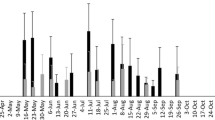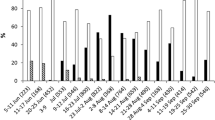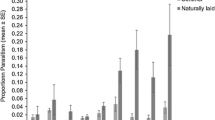Abstract
A 3-year survey was carried out to assess the impact of egg parasitoids on Halyomorpha halys in northern Italy. In total, 1826 H. halys egg masses were collected in the 3 years, and parasitoid adults emerged from 12% of eggs in 2016 and 2017, and from 21% in 2018. Anastatus bifasciatus was the main species emerging from H. halys eggs at all sites and years, confirming its ability to develop on fresh H. halys eggs. Only a few adults of native scelionid species emerged: Trissolcus kozlovi (first record in Italy), T. semistriatus, T. basalis and Telenomus turesis. In addition, a few adults of the Nearctic hyperparasitoid Acroclisoides solus (first record in Europe) were obtained from H. halys eggs collected at different sites. In 2018, for the first time an adventive population of Trissolcus japonicus was also recorded at one site, where the parasitism rate by the parasitoid species complex was overall higher than in 2016 and 2017. An additional supplemental survey at other sites of northern Italy in 2018 revealed the presence of T. japonicus and Trissolcus mitsukurii. The distribution and abundance of T. japonicus, T. mitsukurii and A. solus should be further investigated. Their host range and their interaction with native egg parasitoids, especially with A. bifasciatus, should be also assessed to better understand their potential role in biological control of H. halys.



Similar content being viewed by others
References
Abram PK, Gariepy TD, Boivin G, Brodeur J (2014) An invasive stink bug as an evolutionary trap for an indigenous egg parasitoid. Biol Invas 16(7):1387–1395. https://doi.org/10.1007/s10530-013-0576-y
Abram PK, Hoelmer KA, Acebes-Doria A, Andrews H, Beers EH, Bergh JC, Bessin R, Biddinger D, Botch P, Buffington ML, Cornelius ML, Costi E, Delfosse ES, Dieckhoff C, Dobson R, Donais Z, Grieshop M, Hamilton G, Haye T, Hedstrom C, Herlihy MV, Hoddle MS, Hooks CRR, Jentsch P, Joshi NK, Kuhar TP, Lara J, Lee JC, Legrand A, Leskey TC, Lowenstein D, Maistrello L, Mathews CR, Milnes JM, Morrison WR, Nielsen AL, Ogburn EC, Pickett CH, Poley K, Pote J, Radl J, Shrewsbury PM, Talamas E, Tavella L, Walgenbach JF, Waterworth R, Weber DC, Welty C, Wiman NG (2017) Indigenous arthropod natural enemies of the invasive brown marmorated stink bug in North America and Europe. J Pest Sci 90(4):1009–1020. https://doi.org/10.1007/s10340-017-0891-7
Arakawa R, Namura Y (2002) Effects of temperature on development of three Trissolcus spp. (Hymenoptera: Scelionidae), egg parasitoids of the brown marmorated stink bug, Halyomorpha halys (Hemiptera: Pentatomidae). Entomol Sci 5(2):215–218
Arakawa R, Miura M, Fujita M (2004) Effects of host species on the body size, fecundity, and longevity of Trissolcus mitsukurii (Hymenoptera: Scelionidae), a solitary egg parasitoid of stink bugs. Appl Entomol Zool 39(1):177–181. https://doi.org/10.1303/aez.2004.177
Askew RR, Nieves-Aldrey JL (2004) Further observations on Eupelminae (Hymenoptera, Chalcidoidea, Eupelmidae) in the Iberian Peninsula and Canary Islands, including descriptions of new species. Graellsia 60(1):27–39
Avila GA, Charles JG (2018) Modelling the potential geographic distribution of Trissolcus japonicus: a biological control agent of the brown marmorated stink bug, Halyomorpha halys. BioControl 63(4):505–518. https://doi.org/10.1007/s10526-018-9866-8
Bin F, Vinson SB (1991) Efficacy assessment in egg parasitoids (Hymenoptera); proposal for a unified terminology. In: Wajnberg E, Vinson SB (eds) Trichogramma and other parasitoids. 3rd International Symposium on Le Colloques de l’INRA, vol 56, pp 175–179
Bosco L, Moraglio ST, Tavella L (2018) Halyomorpha halys, a serious threat for hazelnut in newly invaded areas. J Pest Sci 91(2):661–670. https://doi.org/10.1007/s10340-017-0937-x
Botch PS, Delfosse ES (2018) Host-acceptance behavior of Trissolcus japonicus (Hymenoptera: Scelionidae) reared on the invasive Halyomorpha halys (Heteroptera: Pentatomidae) and nontarget species. Environ Entomol 47(2):403–411. https://doi.org/10.1093/ee/nvy014
Carpenter JM (1999) Towards simultaneous analysis of morphological and molecular data in Hymenoptera. Zool Scr 28:251–260. https://doi.org/10.1046/j.1463-6409.1999.00009.x
Cock MJ, van Lenteren JC, Brodeur J, Barratt BI, Bigler F, Bolckmans K, Consoli FL, Haas F, Mason PG, Parra JRP (2010) Do new access and benefit sharing procedures under the convention on biological diversity threaten the future of biological control? Biocontrol 55(2):199–218
Costi L, Haye T, Maistrello L (2019) Surveying native egg parasitoids and predators of the invasive Halyomorpha halys in Northern Italy. J Appl Entomol 143(3):299–307. https://doi.org/10.1111/jen.12590
Dieckhoff C, Tatman KM, Hoelmer KA (2017) Natural biological control of Halyomorpha halys by native egg parasitoids: a multi-year survey in northern Delaware. J Pest Sci 90(4):1143–1158. https://doi.org/10.1007/s10340-017-0868-6
Folmer O, Black M, Hoeh W, Lutz R, Vrijenhoek R (1994) DNA primers for amplification of mitochondrial cytochrome c oxidase subunit I from diverse metazoan invertebrates. Mol Mar Biol Biotechnol 3(5):294–299
Gariepy TD, Haye T, Zhang J (2014) A molecular diagnostic tool for the preliminary assessment of host–parasitoid associations in biological control programmes for a new invasive pest. Mol Ecol 23:3912–3924. https://doi.org/10.1111/mec.12515
Gariepy TD, Bruin A, Konopka J, Scott-Dupree C, Fraser H, Bon MC, Talamas E (2019) A modified DNA barcode approach to define trophic interactions between native and exotic pentatomids and their parasitoids. Mol Ecol 28(2):456–470. https://doi.org/10.1111/mec.14868
Grissell EE, Smith DR (2006) First report of Acroclisoides Girault and Dodd (Hymenoptera: Pteromalidae) in the western Hemisphere, with description of a new species. Proc Entomol Soc Wash 108(4):923–929
Haye T, Fischer S, Zhang J, Gariepy T (2015a) Can native egg parasitoids adopt the invasive brown marmorated stink bug, Halyomorpha halys (Heteroptera: Pentatomidae), in Europe? J Pest Sci 88(4):693–705. https://doi.org/10.1007/s10340-015-0671-1
Haye T, Gariepy T, Hoelmer KA, Rossi JP, Streito JC, Tassus X, Desneux N (2015b) Range expansion of the invasive brown marmorated stinkbug, Halyomorpha halys: an increasing threat to field, fruit and vegetable crops worldwide. J Pest Sci 88(4):665–673. https://doi.org/10.1007/s10340-015-0670-2
Haye T, Moraglio ST, Stahl J, Visentin S, Gregorio T, Tavella L (2019) Fundamental host range of Trissolcus japonicus in Europe. J Pest Sci 1:1–12. https://doi.org/10.1007/s10340-019-01127-3
Hedstrom C, Lowenstein D, Andrews H, Bai B, Wiman N (2017) Pentatomid host suitability and the discovery of introduced populations of Trissolcus japonicus in Oregon. J Pest Sci 90(4):1169–1179. https://doi.org/10.1007/s10340-017-0892-6
Javahery M (1994) Development of eggs in some true bugs (Hemiptera–Heteroptera). Part I. Pentatomoidea. Can Entomol 126(2):401–433. https://doi.org/10.4039/Ent126401-2
Johnson NF (1984) Systematics of Nearctic Telenomus: classification and revisions of the podisi and phymatae species groups (Hymenoptera: Scelionidae). Bull Ohio Biol Surv 6(3):1–113
Jones W (1988) World review of the parasitoids of the southern green stink bug, Nezara viridula (L.) (Heteroptera: Pentatomidae). Ann Entomol Soc Am 81(2):262–273. https://doi.org/10.1093/aesa/81.2.262
Jones AL, Jennings DE, Hooks CRR, Shrewsbury PM (2014) Sentinel eggs underestimate rates of parasitism of the exotic brown marmorated stink bug, Halyomorpha halys. Biol Control 78:61–66. https://doi.org/10.1016/j.biocontrol.2014.07.011
Jones AL, Jennings DE, Hooks CRR, Shrewsbury PM (2017) Field surveys of egg mortality and indigenous egg parasitoids of the brown marmorated stink bug, Halyomorpha halys, in ornamental nurseries in the mid-Atlantic region of the USA. J Pest Sci 90(4):1159–1168. https://doi.org/10.1007/s10340-017-0890-8
Kononova SV (2014) Egg-parasitoids of the genus Trissolcus (Hymenoptera, Scelionidae, Telenominae) from the Palaearctic fauna (the flavipes morphological group). 1. New species of the genus Trissolcus. Entomol Rev 94(7):1019–1030. https://doi.org/10.1134/S0013873814070112
Kononova SV (2015) Egg-parasitoids of the genus Trissolcus (Hymenoptera, Scelionidae, Telenominae) from the Palaearctic region. The flavipes morphological group: 2. A key to the species of the flavipes group. Entomol Rev 95(2):257–264. https://doi.org/10.1134/s0013873815020086
Konopka JK, Haye T, Gariepy T, Mason P, Gillespie D, McNeil JN (2017a) An exotic parasitoid provides an invasional lifeline for native parasitoids. Ecol Evol 7(1):277–284. https://doi.org/10.1002/ece3.2577
Konopka JK, Haye T, Gariepy TD, McNeil JN (2017b) Possible coexistence of native and exotic parasitoids and their impact on control of Halyomorpha halys. J Pest Sci 90(4):1119–1125. https://doi.org/10.1007/s10340-017-0851-2
Konopka JK, Gariepy TD, Haye T, Zhang J, Rubin BD, McNeil JN (2019) Exploitation of pentatomids by native egg parasitoids in the native and introduced ranges of Halyomorpha halys: a molecular approach using sentinel egg masses. J Pest Sci 92(2):609–619. https://doi.org/10.1007/s10340-018-01071-8
Kozlov MA, Kononova SV (1983) Telenominae of the fauna of the USSR. Nauka, Leningrad, p 336
Kozlov MA, Lê XH (1977) Palearctic species of egg parasites of the genus Trissolcus Ashmead, 1893 (Hymenoptera, Scelionidae, Telenominae). Insects Mong 5:500–525. https://doi.org/10.5281/zenodo.23933
Kriticos DJ, Kean JM, Phillips CB, Senay SD, Acosta H, Haye T (2017) The potential global distribution of the brown marmorated stink bug, Halyomorpha halys, a critical threat to plant biosecurity. J Pest Sci 90(4):1033–1043. https://doi.org/10.1007/s10340-017-0869-5
Kuhar TP, Kamminga K (2017) Review of the chemical control research on Halyomorpha halys in the USA. J Pest Sci 90(4):1021–1031. https://doi.org/10.1007/s10340-017-0859-7
Lee DH, Short BD, Joseph SV, Bergh JC, Leskey TC (2013) Review of the biology, ecology, and management of Halyomorpha halys (Hemiptera: Pentatomidae) in China, Japan, and the Republic of Korea. Environ Entomol 42(4):627–641. https://doi.org/10.1603/EN13006
Leskey TC, Nielsen AL (2018) Impact of the brown marmorated stink bug in North America and Europe: history, biology, ecology, and management. Annu Rev Entomol 63:599–618. https://doi.org/10.1146/annurev-ento-020117-043226
Maistrello L, Vaccari G, Caruso S, Costi E, Bortolini S, Macavei L, Foca G, Ulrici A, Bortolotti PP, Nannini R, Casoli L, Fornaciari M, Mazzoli GL, Dioli P (2017) Monitoring of the invasive Halyomorpha halys, a new key pest of fruit orchards in northern Italy. J Pest Sci 90(4):1231–1244. https://doi.org/10.1007/s10340-017-0896-2
Milnes JM, Wiman NG, Talamas EJ, Brunner JF, Hoelmer KA, Buffington ML, Beers EH (2016) Discovery of an exotic egg parasitoid of the brown marmorated stink bug, Halyomorpha halys (Stål) in the Pacific Northwest. Proc Entomol Soc Wash 118(3):466–470. https://doi.org/10.4289/0013-8797.118.3.466
Mohammadpour M, Ziaaddini M, Jalali MA, Hashemirad H, Mohammadi-Khoramabadi A (2016) Egg parasitoids of the pistachio green stink bug, Brachynema germari (Hemiptera: Pentatomidae) in Kerman province, Iran. Zool Ecol 26(1):28–34. https://doi.org/10.1080/21658005.2015.1120544
Morrison WR III, Mathews CR, Leskey TC (2016) Frequency, efficiency, and physical characteristics of predation by generalist predators of brown marmorated stink bug (Hemiptera: Pentatomidae) eggs. Biol Control 97:120–130. https://doi.org/10.1016/j.biocontrol.2016.03.008
Morrison WR III, Blaauw BR, Nielsen AL, Talamas E, Leskey TC (2018) Predation and parasitism by native and exotic natural enemies of Halyomorpha halys (Stål) (Hemiptera: Pentatomidae) eggs augmented with semiochemicals and differing host stimuli. Biol Control 121:140–150. https://doi.org/10.1016/j.biocontrol.2018.02.016
Nishimoto H, Fujita T, Tanaka T, Katou S (2015) Interspecific competition between two scelionid egg parasitoids, the non-native, invasive Trissolcus basalis (Wollaston) and the native Trissolcus mitsukurii (Ashmead) on the southern green stink bug Nezara viridula (Linnaeus) in Japan. Annu Rep Kansai Plant Prot Soc 57:37–48
Ogburn EC, Bessin R, Dieckhoff C, Dobson R, Grieshop M, Hoelmer KA, Mathews C, Moore J, Nielsen AL, Poley K, Pote JM, Rogers M, Welty C, Walgenbach JF (2016) Natural enemy impact on eggs of the invasive brown marmorated stink bug, Halyomorpha halys (Stål) (Hemiptera: Pentatomidae), in organic agroecosystems: a regional assessment. Biol Control 101:39–51. https://doi.org/10.1016/j.biocontrol.2016.06.002
Rice KB, Bergh CJ, Bergmann EJ, Biddinger DJ, Dieckoff C et al (2014) Biology, ecology, and management of brown marmorated stink bug (Hemiptera: Pentatomidae). J Integr Pest Manag 5(3):A1–A13. https://doi.org/10.1603/IPM14002
Rondoni G, Bertoldi V, Malek R, Foti MC, Peri E, Maistrello L, Haye T, Conti E (2017) Native egg parasitoids recorded from the invasive Halyomorpha halys successfully exploit volatiles emitted by the plant–herbivore complex. J Pest Sci 90(4):1087–1095. https://doi.org/10.1007/s10340-017-0861-0
Roversi PF, Binazzi F, Marianelli L, Costi E, Maistrello L, Sabbatini Peverieri G (2016) Searching for native egg-parasitoids of the invasive alien species, Halyomorpha halys Stål (Heteroptera Pentatomidae) in Southern Europe. Redia 99:63–70. https://doi.org/10.19263/REDIA-99.16.01
Sabbatini Peverieri G, Talamas E, Bon MC, Marianelli L, Bernardinelli I, Malossini G, Benvenuto L, Roversi PF, Hoelmer K (2018) Two Asian egg parasitoids of Halyomorpha halys (Stål) (Hemiptera, Pentatomidae) emerge in northern Italy: Trissolcus mitsukurii (Ashmead) and Trissolcus japonicus (Ashmead) (Hymenoptera, Scelionidae). J Hymenopt Res 67:37–53. https://doi.org/10.3897/jhr.67.30883
Stahl JM, Babendrier D, Haye T (2018) Using the egg parasitoid Anastatus bifasciatus against the invasive brown marmorated stink bug in Europe: can non-target effects be rouled out? J Pest Sci 91(3):1005–1017. https://doi.org/10.1007/s10340-018-0969-x
Stahl JM, Babendrier D, Haye T (2019a) Life history of Anastatus bifasciatus, a potential biological control agent of the brown marmorated stink bug in Europe. Biol Contr 129:178–186. https://doi.org/10.1016/j.biocontrol.2018.10.016
Stahl JM, Babendreier D, Marazzi C, Caruso S, Costi E, Maistrello L, Haye T (2019b) Can Anastatus bifasciatus be used for augmentative biological control of the Brown Marmorated Stink Bug in fruit orchards? Insects 10(4):108. https://doi.org/10.3390/insects10040108
Stahl JM, Tortorici F, Pontini M, Bon MC, Hoelmer KA, Marazzi C, Tavella L, Haye T (2019c) First discovery of adventive populations of Trissolcus japonicus in Europe. J Pest Sci 92(2):371–379. https://doi.org/10.1007/s10340-018-1061-2
Talamas E, Buffington M, Hoelmer KA (2013) New synonymy of Trissolcus halyomorphae Yang. J Hymenopt Res 33:113–117. https://doi.org/10.3897/jhr.33.5627
Talamas EJ, Herlihy MV, Dieckhoff C, Hoelmer KA, Buffington M, Bon MC, Weber DC (2015) Trissolcus japonicus (Ashmead) (Hymenoptera, Scelionidae) emerges in North America. J Hymenopt Res 43:119–128. https://doi.org/10.3897/JHR.43.4661
Talamas EJ, Buffington ML, Hoelmer KA (2017) Revision of palearctic Trissolcus Ashmead (Hymenoptera, Scelionidae). J Hymenopt Res 56:3–185. https://doi.org/10.3897/jhr.56.10158
Yang Z-Q, Yao Y-X, Qiu L-F, Li Z-X (2009) A new species of Trissolcus (Hymenoptera: Scelionidae) parasitizing eggs of Halyomorpha halys (Heteroptera: Pentatomidae) in China with comments on its biology. Ann Entomol Soc Am 102(1):39–47. https://doi.org/10.1603/008.102.0104
Yang YL, Zhong YZ, Zhang F, Zhou CQ, Yang SY, Zhang JP (2015) Parasitic capacity of Trissolcus halyomorphae and T. flavipes (Hymenoptera: Scelionidae) on eggs of Halyomorpha halys. Chin J Environ Entomol 37(6):1257–1262
Zhang J, Zhang F, Gariepy T, Mason P, Gillespie D, Talamas E, Haye T (2017) Seasonal parasitism and host specificity of Trissolcus japonicus in northern China. J Pest Sci 90(4):1127–1141. https://doi.org/10.1007/s10340-017-0863-y
Zhu G, Gariepy TD, Haye T, Bu W (2017) Patterns of niche filling and expansion across the invaded ranges of Halyomorpha halys in North America and Europe. J Pest Sci 90(4):1045–1057. https://doi.org/10.1007/s10340-016-0786-z
Acknowledgements
We thank Michael Gates (U.S. National Museum of Natural History, Smithsonian Institution, Washington, USA) for the loan of A. solus holotype and Paolo Navone for the identification of A. solus specimens. This research was funded by Fondazione Cassa di Risparmio di Cuneo (Project HALY-END) and Regione Piemonte (Project BIOHALY).
Author information
Authors and Affiliations
Corresponding author
Ethics declarations
Conflict of interest
The authors declare that they have no conflict of interest.
Additional information
Communicated by D.C. Weber.
Publisher's Note
Springer Nature remains neutral with regard to jurisdictional claims in published maps and institutional affiliations.
Electronic supplementary material
Below is the link to the electronic supplementary material.
Rights and permissions
About this article
Cite this article
Moraglio, S.T., Tortorici, F., Pansa, M.G. et al. A 3-year survey on parasitism of Halyomorpha halys by egg parasitoids in northern Italy. J Pest Sci 93, 183–194 (2020). https://doi.org/10.1007/s10340-019-01136-2
Received:
Revised:
Accepted:
Published:
Issue Date:
DOI: https://doi.org/10.1007/s10340-019-01136-2




